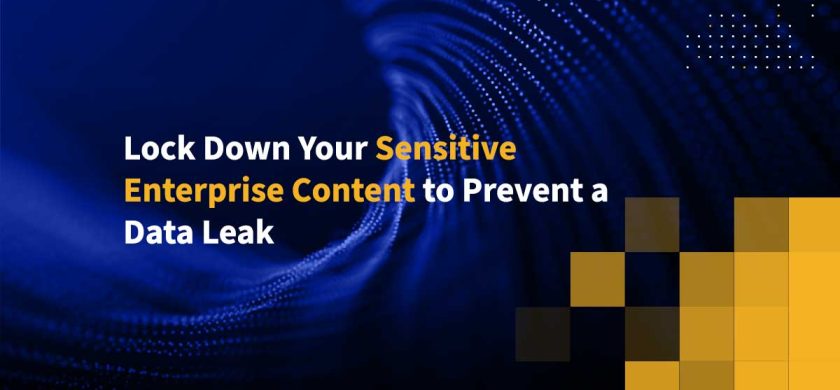
Lock Down Your Sensitive Enterprise Content to Prevent a Data Leak
Your enterprise content is everywhere. Literally everywhere. On laptops, phones, in on premise servers, and in the cloud. Employees can access content – much of it sensitive – from any location, allowing them to work from any location at any time. But content that’s easily available is also easily susceptible to a data leak. Without comprehensive data encryption and secure data access at all levels, from physical data storage to network communications, a data breach is practically a foregone conclusion.
The modern enterprise spends millions of dollars on cyber security, yet the modern CISO can’t say in any specific detail what information is entering and leaving the firm. If you can’t see it, you can’t defend it. Everyday workflows where employees exchange sensitive information with external parties expose the firm to constant threats, including leaks, phishing, malicious files, and compliance violations. These external workflow threats have a common theme: a user is the actor, and a file is the agent. Complete protection requires a defense that spans the full breadth of the associated threat surface: the collective paths of all files entering and leaving your organization.
In my last blog post, I discussed shrinking the threat surface by constructing secure external and internal perimeters. Today, I’ll discuss hardening the threat surface to prevent unauthorized access to sensitive data.
Harden the Threat Surface
Every point along the external workflow threat surface should be hardened to protect against a data breach. The first order of business should be to lock down access to the entrances and exits that let files in and out of your organization. External file sharing should only be allowed through approved end user applications and content repositories secured by enterprise content access.
Access should be tightly controlled via security integrations with standard SSO and LDAP implementations, and multi-factor authentication for the most sensitive content. All enterprise content repositories should be encrypted. All file transfers should be encrypted from origin to destination. Systems managing external file transfers should be hardened as well and have severely restricted access.
Choose Wisely When Storing Data in the Cloud
Public cloud storage presents a significant risk for storing truly sensitive content, such as legal documents, health records and proprietary IP. It not only exposes data to unauthorized access by unknown third parties, but the consolidation of data creates a honey pot for attackers and increases the risk of a large-scale breach.

Depending on jurisdiction, that honey pot can even attract the government. For example, the US Federal Cloud Act of 2018 allows US law enforcement to compel technology companies via subpoena to provide data stored on their servers, regardless of whether the data is stored in the U.S. or on foreign soil. In plain English, your sensitive data can be collected in bulk without your knowledge or approval. As a result, an on-premise, private cloud, or a hybrid cloud deployment for content repositories should be the standard for truly sensitive information and IP.
In the next post, I’ll discuss defending the threat surface against internal threats by employing tight governance over file transfers to prevent data breaches. Unless you ensure that all sensitive files are stored in the appropriate content repository where access can be tightly managed and monitored, sensitive files can leak out undetected. Future posts will cover concepts like blocking malicious attacks and building a holistic, proactive defense that spans the entire threat surface.
To learn more about hardening the threat surface to prevent unauthorized access to sensitive data, schedule a custom demo of Kiteworks today.
Frequently Asked Questions
Third-party risk management is a strategy that organizations implement to identify, assess, and mitigate risks associated with their interactions with third-party vendors, suppliers, or partners. These risks can range from data breaches and security threats to compliance issues and operational disruptions. The process typically involves conducting due diligence before engaging with a third party, continuously monitoring the third party’s activities and performance, and implementing controls to manage identified risks. The goal is to ensure that the third party’s actions or failures do not negatively impact the organization’s operations, reputation, or legal obligations.
Third-party risk management is crucial because it helps to identify, assess, and mitigate the risks associated with third-party relationships. This can include cybersecurity threats, compliance issues, operational risks, and reputational damage.
Policy controls are essential in third-party risk management as they establish clear expectations for third-party behavior, data handling, and security practices. They help mitigate the risk of security incidents by defining acceptable actions, and ensure third parties comply with relevant laws, regulations, and industry standards. Further, policy controls provide a foundation for monitoring third-party activities and enforcing compliance, allowing the organization to take appropriate action in case of policy violations. Thus, policy controls serve as a critical framework for managing third-party risks effectively.
Audit logs are integral to third-party risk management as they offer a comprehensive record of all third-party activities within your systems. They aid in identifying potential risks by highlighting unusual or suspicious activities, serve as a crucial resource during incident response and forensic investigations, and help ensure regulatory compliance by providing proof of effective security measures and third-party monitoring. In addition, they foster a culture of accountability and transparency among third parties, deterring malicious activities and encouraging adherence to security policies.
Kiteworks helps with third-party risk management by providing a secure platform for sharing and managing sensitive content. The platform is designed to control, track, and secure sensitive content that moves within, into, and out of an organization, significantly improving risk management. Kiteworks also provides two levels of email encryption, Enterprise and Email Protection Gateway (EPG), to secure sensitive email communications. This helps to protect against third-party risks associated with email communication.
Additional Resources
- Blog Post Most Secure File Sharing Options
- Blog Post File Sharing for Enterprise
- Blog Post How Do Different Regulations Define Data Compliance?
- Blog Post Leading Cause of Data Breaches
- Blog Post Secure File Sharing Important